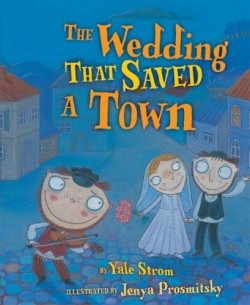The Wedding That Saved a Town
Weddings are a facet of every culture, however their purposes and their customs vary greatly between cultures. Gaining an understanding of various customs often leads to cultural respect, and thus award-winning author Yale Strom’s book can serve as a way to expose children to a traditional European Jewish wedding custom. Strom is also a renowned klezmer musician, filmmaker, and scholar of the Jewish faith.
In this modern folk-tale, the main character, Yiske, is asked to perform at a wedding. Yiske gladly accepts the offer, but he soon learns of the grim reasoning for the wedding. The people of the town are sick, and only a traditional “shvartze chaseneh” can help lift the illness. Yiske then sets his mind to finding the perfect couple for the wedding in hopes of a cure. The last page of the book contains an author’s note and a glossary of Yiddish words that are seen throughout the book.
Jenya Prosmitksy’s illustrations are cartoon-like, bringing light to what may appear otherwise as a dismal tradition. Colorful and full of expression, they compliment Strom’s strong characters. Prosmit-sky grew up in the former USSR and has illustrated other children’s books, including, A Mink, A Fink, A Skating Rink: What is a Noun? and Hairy, Scary, Ordinary: What is an Adjective?
The book is valuable for children and educators alike. For children, it is a hopeful and animated tale. For educators, the book can be used to enhance multiculturalism in the classroom. In addition, Jewish students might feel more comfortable in the classroom if a traditional tale of theirs were integrated with dominate Christian traditions.
Reviewed by
Kaitlyn Moore
Disclosure: This article is not an endorsement, but a review. The publisher of this book provided free copies of the book to have their book reviewed by a professional reviewer. No fee was paid by the publisher for this review. Foreword Reviews only recommends books that we love. Foreword Magazine, Inc. is disclosing this in accordance with the Federal Trade Commission’s 16 CFR, Part 255.

